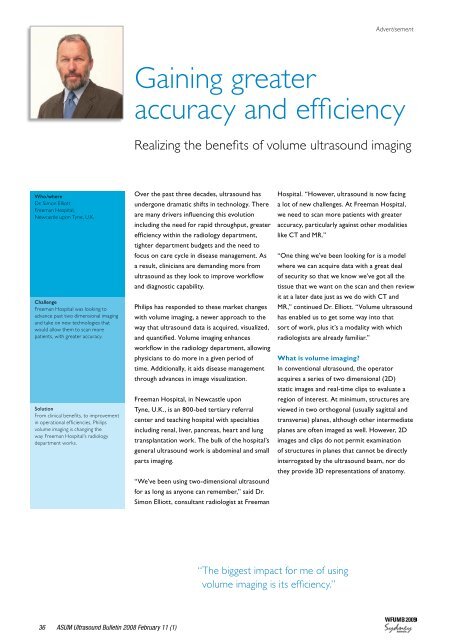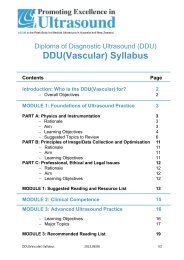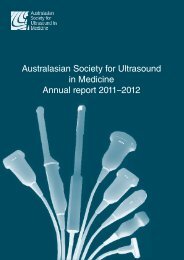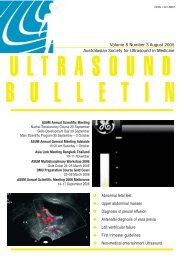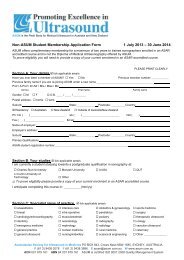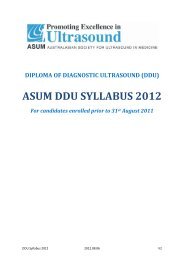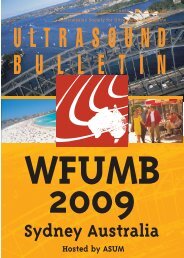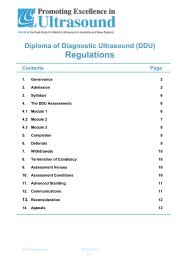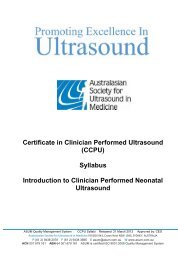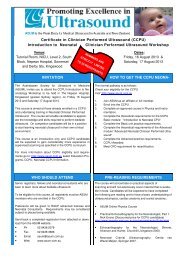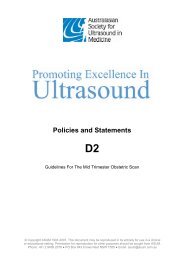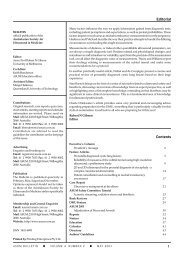Volume 11 Issue 1 (February) - Australasian Society for Ultrasound ...
Volume 11 Issue 1 (February) - Australasian Society for Ultrasound ...
Volume 11 Issue 1 (February) - Australasian Society for Ultrasound ...
Create successful ePaper yourself
Turn your PDF publications into a flip-book with our unique Google optimized e-Paper software.
Advertisement<br />
Gaining greater<br />
accuracy and efficiency<br />
Realizing the benefits of volume ultrasound imaging<br />
Who/where<br />
Dr. Simon Elliott<br />
Freeman Hospital,<br />
Newcastle upon Tyne, U.K.<br />
Challenge<br />
Freeman Hospital was looking to<br />
advance past two dimensional imaging<br />
and take on new technologies that<br />
would allow them to scan more<br />
patients, with greater accuracy.<br />
Solution<br />
From clinical benefits, to improvement<br />
in operational efficiencies, Philips<br />
volume imaging is changing the<br />
way Freeman Hospital’s radiology<br />
department works.<br />
Over the past three decades, ultrasound has<br />
undergone dramatic shifts in technology. There<br />
are many drivers influencing this evolution<br />
including the need <strong>for</strong> rapid throughput, greater<br />
efficiency within the radiology department,<br />
tighter department budgets and the need to<br />
focus on care cycle in disease management. As<br />
a result, clinicians are demanding more from<br />
ultrasound as they look to improve workflow<br />
and diagnostic capability.<br />
Philips has responded to these market changes<br />
with volume imaging, a newer approach to the<br />
way that ultrasound data is acquired, visualized,<br />
and quantified. <strong>Volume</strong> imaging enhances<br />
workflow in the radiology department, allowing<br />
physicians to do more in a given period of<br />
time. Additionally, it aids disease management<br />
through advances in image visualization.<br />
Freeman Hospital, in Newcastle upon<br />
Tyne, U.K., is an 800-bed tertiary referral<br />
center and teaching hospital with specialties<br />
including renal, liver, pancreas, heart and lung<br />
transplantation work. The bulk of the hospital’s<br />
general ultrasound work is abdominal and small<br />
parts imaging.<br />
“We’ve been using two-dimensional ultrasound<br />
<strong>for</strong> as long as anyone can remember,” said Dr.<br />
Simon Elliott, consultant radiologist at Freeman<br />
Hospital. “However, ultrasound is now facing<br />
a lot of new challenges. At Freeman Hospital,<br />
we need to scan more patients with greater<br />
accuracy, particularly against other modalities<br />
like CT and MR.”<br />
“One thing we’ve been looking <strong>for</strong> is a model<br />
where we can acquire data with a great deal<br />
of security so that we know we’ve got all the<br />
tissue that we want on the scan and then review<br />
it at a later date just as we do with CT and<br />
MR,” continued Dr. Elliott. “<strong>Volume</strong> ultrasound<br />
has enabled us to get some way into that<br />
sort of work, plus it’s a modality with which<br />
radiologists are already familiar.”<br />
What is volume imaging?<br />
In conventional ultrasound, the operator<br />
acquires a series of two dimensional (2D)<br />
static images and real-time clips to evaluate a<br />
region of interest. At minimum, structures are<br />
viewed in two orthogonal (usually sagittal and<br />
transverse) planes, although other intermediate<br />
planes are often imaged as well. However, 2D<br />
images and clips do not permit examination<br />
of structures in planes that cannot be directly<br />
interrogated by the ultrasound beam, nor do<br />
they provide 3D representations of anatomy.<br />
“The biggest impact <strong>for</strong> me of using<br />
volume imaging is its efficiency.”<br />
6 ASUM <strong>Ultrasound</strong> Bulletin 2008 <strong>February</strong> <strong>11</strong> (1)


